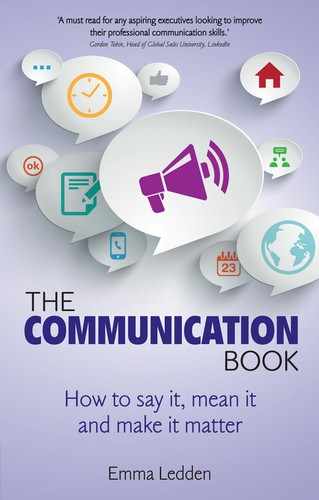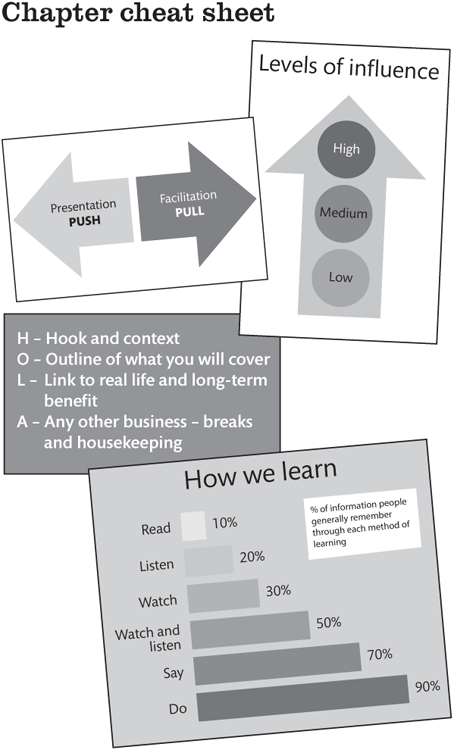STEP 1
Know the purpose
Facilitation is leading or guiding a group so they achieve a common goal.
You can facilitate workshops, training courses and meetings, both internally within your company and externally with a client or public group.
Great facilitating is like being a party host. You begin plagued with the usual questions of will anyone turn up, will they have fun and will they behave themselves? (There is always one.) Then there is all the planning and preparation. You are in charge of the entire experience and you need to have everything ready when people arrive.
Finally, on the day itself, you work very hard to make sure everyone is having the best possible time, catering to everyone’s needs until they all leave and you collapse from exhaustion probably feeling like you coulda/shoulda/woulda done more.
The difference between presenting and facilitating

The most important thing to say at this stage is that facilitation is not presentation, and presenting is not facilitating.
Presenters focus on giving one-way information. This is a perfect dynamic to deliver some key messages but it will not lead to any behaviour change, new skills development or sharing of experiences.
If the goal is to give the listener or the group a new skill, share experiences or change behaviour in the long term, you can’t just stand at the top of a room lecturing to a group. You must create an experience that allows for two-way communication.
In order to create this experience, you must facilitate, not present.
The skill of a facilitator involves:
- conveying information in a way that allows the participants to explore the topic and come to their own conclusions;
- using questioning and active listening;
- managing group activities and discussions;
- responding to the listeners’ behaviours and the group dynamic.
A facilitator must get information across to gain engagement and stimulate discussion, but then they must manage the discussion, listen and pull out the key learnings for the group.
The truth is, facilitators need to do a mix of presenting and facilitating – a mix of pushing and pulling.
The fact of facilitation
There is a very famous saying from Benjamin Franklin:
‘Tell me and I forget, teach me and I may remember, involve me and I learn.’
BENJAMIN FRANKLIN
Turns out that he was right.
How we learn
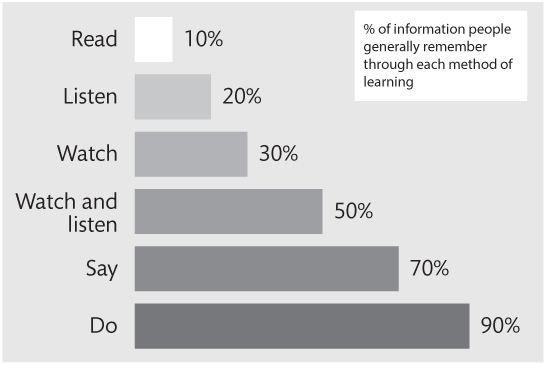
Source: Figure derived from Dale, E. (1946) Audio-visual methods in teaching, New York: The Dryden Press.
Facilitation is the skill of telling, showing and allowing the listener to experience. This guarantees the best possible result and retention. Facilitating helps people to learn on their own, rather than telling them what to do.
Facilitators use questioning and listening skills to lead a group and, most importantly, a facilitator gives the group time and space to understand, learn and contribute.
THE SKILL-SET OF A GREAT FACILITATOR
- Communication skills
- Questioning and listening skills (as discussed in Chapter 1)
- Patience
- Confidence
- Approachability
- Understanding and empathy
- Good knowledge of the topic (does not have to be an expert)
The facilitator is 100 per cent responsible for the experience created for a group, so they must:
- prepare their own materials and work out a training timetable;
- ensure the room is suitable, and properly laid out for a group of people;
- ensure all equipment is in working order before participants arrive;
- be present before participants arrive and ready to welcome them;
- greet each individual, learning their names and remembering them;
- introduce people if they don’t already know one another;
- create a friendly and easy atmosphere;
- start and finish the session on time;
- be fully prepared, and deliver an engaging and interesting session.
STEP 2
Know your listener
The fundamental you need to always remember with facilitation in business is that you are dealing with an adult audience. Adults learn and contribute in a unique way that is different to how we learnt in school.
How adults learn
Pedagogy vs andragogy
Pedagogy: derived from the Greek words ‘ped’, meaning ‘child’ and ‘agogus’, meaning ‘leader of’. Therefore, pedagogy literally means the science of leading (teaching) children.
Andragogy: described as ‘the art and science of helping adults learn’ and could be seen as the opposite of the pedagogical approach.
As a facilitator you will be applying an andragogical approach, so you need to bear in mind the following.
What’s in it for me?
Remember this guy?

Adults need to know why they need to learn. Adults have a keen desire to establish ‘What’s in it for me?’ before they invest in the process.
You need to emphasise the importance of the training event or workshop in terms of improving your participants’ jobs and lives.
The need to build on their experience
Adults have developed experience over many years, which needs to be tapped into using appropriate methods. These methods include:
- group discussion;
- role-plays;
- case studies;
- problem-solving activities.
I will go into these in more detail later in the chapter, but the most important thing to know is that a group of adults will learn far more from each other than they will from listening solely to a facilitator. If you are to successfully implement the androgogical model, you need to know your listeners and design a facilitation session that meets their needs.
Learning to ride a bike
Do you remember learning to ride your first bike?
Can you remember if you:
- jumped straight on the bike and just had a go;
- thought about riding the bike a while before getting on;
- needed to understand the mechanics of the bike and how it operated before you could ride it;
- looked for some practical tips from a bike-riding expert (i.e. your mum or dad) before you jumped on.

Whether it is learning to ride a bike or participating in any other learning, we all have different learning styles. There are four learning styles, as found by Peter Honey and Alan Mumford (see www.peterhoney.com):
- Activist: if you are an activist you like fast-paced sessions that involve doing and experiencing things. You are eager to jump feet first into any activity, with little or no instruction. You don’t like sitting around, working alone or too much theory.
- Reflector: if you are a reflector you need time – time to look, time to absorb, time to think, time to answer and time to write. You cannot be rushed and you don’t like going first.
- Theorist: this is the one learning style that needs the detail and the background. You want to know how it all fits and then you want to analyse and check it to be sure. You like ideas and concepts. You do not like anything silly or unclear.
- Pragmatist: this learning style needs the session to be practical, related to the real world and have concrete applications. You love tools, techniques and processes you can implement afterwards. You do not like anything with no relevance or that is intangible.
When you are facilitating a group it could be made up of:
- all activists (my idea of heaven);
- all theorists (my idea of hell);
- a mix of all four styles (most likely).
And… don’t forget you also have a learning style as a facilitator, and your default will be to design and run the workshop or meeting the way you prefer.
For example, I am an activist. Therefore I am a reflector’s and theorist’s worst nightmare. My default is to give zero instruction and expect instant reactions. I even get a bit huffy when they are thinking (reflecting).
Therefore, I must make sure, when I am designing and running a workshop, that I give proper instructions, good written hand-outs and time and space for thought.
STEP 3
Prepare to speak
There are three factors of great facilitation:
- The real start and the right start;
- Information to interaction;
- Managing the group.
The real start
The role of a facilitator begins before the start of the workshop or meeting. You must design the session in full. To design a facilitation session, start by answering these questions:
- By the end of the facilitation, what do you want everyone to leave with? What information do you need from them by the end of the day? Always start with the end in mind.
- Who is in your group? Are they coming to you willingly or is it mandatory? Do they know why they are attending and what the purpose of the day is?
- What is the structure of the session? How many key areas are you going to cover? Is there enough time to cover all you want?
- Do you want people to work in small groups or do you want open discussion in one whole group? Do you want a mix of both?
- When are you taking breaks/stopping for lunch?
- How are you capturing ideas? How many flipcharts and markers do you need? Are you using technology?
- Do you need to send some pre-information? Would that help everyone come in the right frame of mind to the session (remember the theorists)?
The right start
The opening of your facilitation on the day itself is the most important part. You must start on time. The group must know things will run on time and on target. You set the standard for this.
If a number of participants have not yet turned up, you may delay the start time by five minutes, but only by five minutes, and only with the prior agreement of those who have arrived on time.
Don’t say hello, say HOLA
At the beginning of your workshop or meeting, your participants are sitting there with all sorts of thoughts running through their minds – for example:
- Who is this person? (If they don’t know you.)
- What time will this finish?
- What is this going to be about?
- Will it be interesting?
- Why am I here?
As we just explored in the previous section, each individual in the group is simply thinking WIIFM – what’s in it for me?

And you need to make sure you begin your meeting or workshop with a clear and structured answer to this question.
How? By saying HOLA.
H – Hook and context
O – Outline of what you will cover
L – Link to real life and long-term benefit
A – Any other business – breaks and housekeeping
Let me give you an example of how to apply this in real life. Imagine I am running a one-day workshop on facilitation skills, with six managers who, in turn, will be designing and running workshops of their own over the next 12 months:
H
‘Hi, my name is Emma Ledden and you are very welcome to this course called “Facilitating With Impact”. You are all going to be designing and running workshops over the next 12 months; I want to help you do that as confidently and competently as possible.’
O
‘The main areas I will cover today are:
- creating engaging communication, visuals and hand-outs;
- questioning and listening;
- dealing with groups.’
L
‘These skills will help you become a better facilitator and will also help you in client meetings, team projects and presentations in the future.
The session is very practical and tailored around you. I will record you facilitating on a camera and play you back to yourself so you can get awareness of your personal facilitation and presentation style. I will also give you detailed feedback.’
A
‘We will take two coffee breaks and a lunch break, and finish at 5pm. All I ask is for everyone to please turn your phone and laptop off before we begin.’
Should I set ground rules?
One strategy for ensuring your group works together is to begin the day with a list of ground rules about how the group must behave during the meeting or workshop.
You can look at setting ground rules around these areas at the beginning of your course:
- switching off mobile phones;
- punctuality;
- confidentiality;
- listening to each other;
- asking questions;
- being open to new ideas;
- having fun;
- treating each other with respect;
- guidelines for giving and receiving feedback.
I have been a trainer for 10 years and I have never set formal ground rules or asked any group I work with to set them. I do ask for phones and laptops to be turned off, but that is as far as I go. I feel ground rules are too much like school, and I trust that if my opening HOLA is good enough I will gain and keep attention.
In my experience, adult learners are well able to behave properly and they don’t like being patronised, which I fear is what ground rules can do.
This is my opinion, based on my experience. You will have to make the decision whether or not to set ground rules for yourself and your group.
The ultimate combo – introductions and ice-breakers
Once you have said HOLA, the next step is to understand what your participants need from the session. You also need to have an ice-breaker to give the group a chance to get comfortable with each other.
The idea with an ice-breaker is to relieve some of the normal tension that exists in a room with a group of adult learners who may or may not know each other, and who are possibly feeling nervous about the day.
Ice-breakers are about breaking down barriers, creating a more pleasant learning environment and facilitating learning. A ‘good atmosphere’ is not accidental – it can and should be created by the facilitator.
A TOUR OF THE TABLE
If you have a group of fewer than eight people you can simply go around the group one by one, asking each person their name, their personal challenges in the area you are covering and their goal for the training.
Even though it may seem that way on the surface, this is not a simple question-and-answer session. This is a discussion with the purpose of bonding the group, finding common ground and relieving some tension. Take your time and allow a dynamic to develop as you question each person. Find common themes and link people together in their expectations of the day, their challenges or their goals.
A tour of the table is not your only option for an introduction and ice-breaker. You can be more adventurous, depending on the age and size of the group. Here are a few other examples of introductions and ice-breakers.
- Youngest to oldest: this works really well for larger groups (over 12 people and under the age of 30). I ask everyone to stand in line, youngest to oldest, facing me. Then I get each person to tell the group their name, their goal for the session and one interesting thing about themselves.
- Interview each other and introduce: with a smaller group (around 10–12 people), I put the participants into pairs and ask them to interview each other and then present back on the person they are talking to. The questions remain the same: their name, their goal for the day and one interesting thing about themselves.
- The M&M intro: put a packet of chocolate M&Ms in a bowl and ask each person in the group to take one but not to eat it just yet. Put up a slide showing the M&M colours and a corresponding question, such as this:
- Red – best holiday you ever had
- Green – your childhood nickname
- Brown – favourite country you ever visited
- Yellow – your party piece.
Information to interaction
The heart of facilitation lies in getting the group to do the work, rather than the facilitator doing the work.
There a number of ways to do this using the tools below:
- Group discussions: a way of exchanging thoughts and ideas for a set period of time in one large group or in smaller groups. Groups can talk generally about the topic, having a set outcome from the discussion as decided by the facilitator.
- Role-plays: role-plays have been part of learning experiences for a long time and are a way of practising or rehearsing a scenario that may happen in real life. For example, presentations or customer interactions can be practised and perfected in a workshop.
- Case studies: these are very useful in facilitations as they tend to replicate a real-life situation. Using case studies is a way to explore all the possible angles and outcomes of a situation in a safe environment.
- Problem-solving activities: having interactive activities, such as having to build a LEGO tower in groups to demonstrate teamwork or an exercise to organise a weekend away for 10 people with no money, can get groups to interact in a fun and meaningful way.
Let me give you a very simple example of how I would use group discussions to explore the use of visual aids in my ‘Facilitating With Impact’ course.
Starting with my HOLA
H – Now we are going to look at using visual aids during a facilitation workshop and establish what is best practice.
O – The goal is to examine all the possible visual aids you can use and the pros and cons of each type.
L – This session will help you identify the best visuals to use in different scenarios and also how to prepare them.
A – You will be working in groups of three and each group will get a chance to present back to the room on a type of visual aid.
I then ask them to get into groups of three and do this series of exercises:
- Ask them to list all the possible visual aids you can use in a facilitation.
- Assign a visual aid to each group, i.e. one group takes PowerPoint, one takes a flipchart and one takes a hand-out.
- Ask them to come up with their version of best practice, including pros and cons, for their visual aid – based on their experience.
- Ask them to present back to the room as a group on their visual aid’s best practice rules.
Once this is completed, as the facilitator, I can now fill in any gaps that may have been left out.
The goal of facilitation is to make the group do the work, as opposed to just presenting the information at them.
Managing the group
I have been facilitating and training groups for 10 years now. The part I find the most challenging is managing the group dynamic.
Great facilitation looks like this:
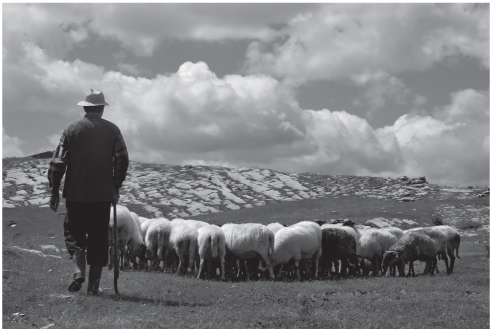
A great facilitator is like a great shepherd. They allow the participants (the sheep) to move from one area to another while keeping everyone safe and keeping the flock intact.
Great facilitation has a clear agenda, starts on time, sticks to time and moves the group to an end-goal, while allowing space to share and debate.
Bad facilitation looks like this:
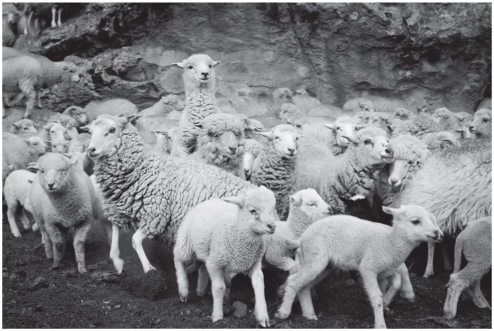
Bad facilitation has the participants (the sheep) running all over the place, baaing like crazy and behaving out of control.
Keeping your participants safe and getting them to the end-goal intact is a challenge for any facilitator.
At any time, a participant can behave in a negative way, which may have a destructive impact on the group and on the learning. These are some of the behaviours you will come across and will need to manage:
- Dominating the group: taking up a great deal of time with comments and questions that may or may not be relevant.
- Acting superior: trying to appear more skilled and knowledgeable than the others in the group or the facilitator.
- Arriving late after breaks: turning up late in the morning and after breaks, giving the impression of a lack of commitment to the session.
- On their phones: continually distracted by and responding to messages under the table or in plain sight.
- Side conversations: two or more participants who are continually having whispered conversations.
- Complaining: continually finding fault with the programme and the facilitator.
- Being unprepared: not having pre-work completed.
- Not engaging: not participating in activities.
- Clowning: joking at inappropriate times, distracting others.
There are several reasons why negative behaviours occur. For example, the participant:
- does not understand the relevance of the programme;
- is afraid of failing or being exposed on the programme;
- has outside pressures and deadlines;
- likes to debate and question data before they accept it as fact;
- enjoys being the centre of attention;
- is not comfortable doing an activity such as role-play in front of the group.
No matter the reason, when you are faced with a problem behaviour that will impact negatively on your group, you must act to manage that behaviour as best you can.
WHEN FACED WITH A DISRUPTIVE PARTICIPANT YOU MUST:
- Manage your own emotions: negative behaviour shows disrespect, which can trigger you emotionally. As a facilitator you may feel defensive or angry.
- Manage the group: make sure you are not monopolised by this one person, as you’re responsible for the whole group.
- Manage the person: you will need to deal directly with the person and their negative behaviour.
In order to do these three things, you need to not take the behaviour personally and you need to intervene using the ‘Levels of influence’.
The ‘Levels of influence’ is a simple concept that may help you in this area.

The ‘Levels of influence’ suggests that, as a general rule, if you have a difficult participant you start by addressing their behaviour in the least impactful way first.
Low-level influence
For example, if you have two people in your group having a side conversation, the following may be the first ways you might try to intervene and solve it:
- give direct eye contact to the pair and hold it for longer than usual;
- pause and wait until you have everyone’s attention;
- move closer to the people concerned.
Medium-level influence
If your problem persists, it may be necessary to move up a level. For example:
- Set up a group activity (in pairs, or small groups) that will change the dynamic in the room and separate the pair so they are no longer sitting together.
- Stop the workshop and have a discussion with the group about the original ground rules, if you set them.
- Have a conversation with the pair over the break and ask them why they are not engaged in the programme.
High-level influence
At the top end of the ‘Levels of influence’ are the more drastic actions you can take – even asking someone to leave the group. You should never have to do this except in a very extreme case as it would represent a failure on the part of the facilitator. You should expect to be able to manage challenging situations in a positive way without making ultimatums or causing things to escalate.
When I began working as a facilitator I was told you will always ‘lose control of one group in your career’. I have yet to completely lose a group but I have come close a few times.
Each facilitator has their own style, and groups respond differently to different people and situations. There is no ‘one size fits all’ in terms of group dynamics. Over time you will develop your own style and ways to manage your groups as a facilitator.
What’s in it for you?
Facilitation is a powerful skill to master in business as it allows you to interact with others in a very engaging and authentic way. It challenges you to be listener-focused, which is at the heart of great communication.
The ability to listen well and ask questions, all the while genuinely caring about the experience you are creating, will allow you to run great meetings, have better relationships and be a great leader to your team.
